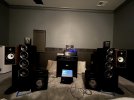I have two unique systems, horn with 15 inch mid woofer vs a standard 3 way bookshelf. The horn system has stereo subs(front left/right corners) time aligned with Audiolense(tri-amp) and the 3 way bookshelf has three subs(front left/right and back left) summed into mono not time aligned though with a correction filter with Audiolense that has time alignment against the mains in the AVR with speaker distance( REW support). I probably will tell them apart in a blind test due to the phenomenan of how the bass evnevelopes and the bass lag(good lag just longer than the stereo, I believe audible) associated with the mono summed bass, possibly 3 subs frequencies arriving at different times to the ear. Of course the stereo subs have more powerful motor structure also allowing you to feel the immediate thump.
Point is that if I take away the subs from both systems, I probably wouldn't tell which system is which, even with such unique radiation patterns of both systems. There have been times when I have been confused which system is playing(even though it takes a few min to turn on the horn system due to the tri-amp nature) before I had my subs so perfectly designed and set up. So I am going to agree with Mitch here, as much as I want to believe that the bigger system sounds larger than life the difference is very small and very hard to discern.
I think this points to exactly how muchof a role subwoofers play in a system and how they can be manipulated to provide a certain sound character to the overall sound.
This made me very curious. I use two systems - 2.2 (lifestyle “bookshelf” L/R) for tv, and 2.2 for music (tall line array L/R).
The subs are the same, 10” sealed 300w continuous / 600w peak; they’re literally moved between the two systems as needed.
Both systems are usually crossed to the subs at 100 Hz.
The tv speakers, despite playing surprisingly well/loud, do sound like what one would expect without the subs. Rather small.
I played a few new-to-me tracks on the music system without the subs on so my brain would be less likely to focus on a “what’s missing” factor (familiar bass notes).
The sound was still very big, especially with vocals since the lines do reach below 100 Hz and handle male voices just fine, only failing to fill out deep resonance in the lowest octave. Depending on listening position in the room, vocals and some instruments also show considerable “height”. I assume this is due to the unorthodox employment of the tweeters (which have very wide horizontal dispersion) in this setup. The uppermost tweeter is ~8.5’ high.
There was, however, still a noteworthy effect on “soundstage width” based on bass (on/off), with subs definitely contributing to a wider (the word enveloping was used in this thread…) soundstage. Without subs, the approximate driver surface area for frequencies up to 6 kHz is 150in^2 per Ch; for frequencies 6 kHz and up, it is ~50in^2 (ribbon tweeters of sorts) per Ch. Perhaps dynamic capability without compression mentioned by
@gnarly and others is sufficient to offset some of the compromises in music playback’s higher frequencies discussed by
@MattHooper ? Surface area maybe being quite important to higher frequencies but more limited (than bass freqs) by conventions of speaker / driver design / implementation?
With regard to sound height, I suspect it’s more due to reflections, or phase issues that people are not supposed to be able to notice.
All just in musing, of course.
@Trdat did you disconnect your two systems’ subs (+ use new-to-you tracks) to see if your assumption re: bass determining most of the difference in “size” applied to either setup?


